Results showed improved fish survival rate, weight gain rate, specific growth, immunity and disease resistance
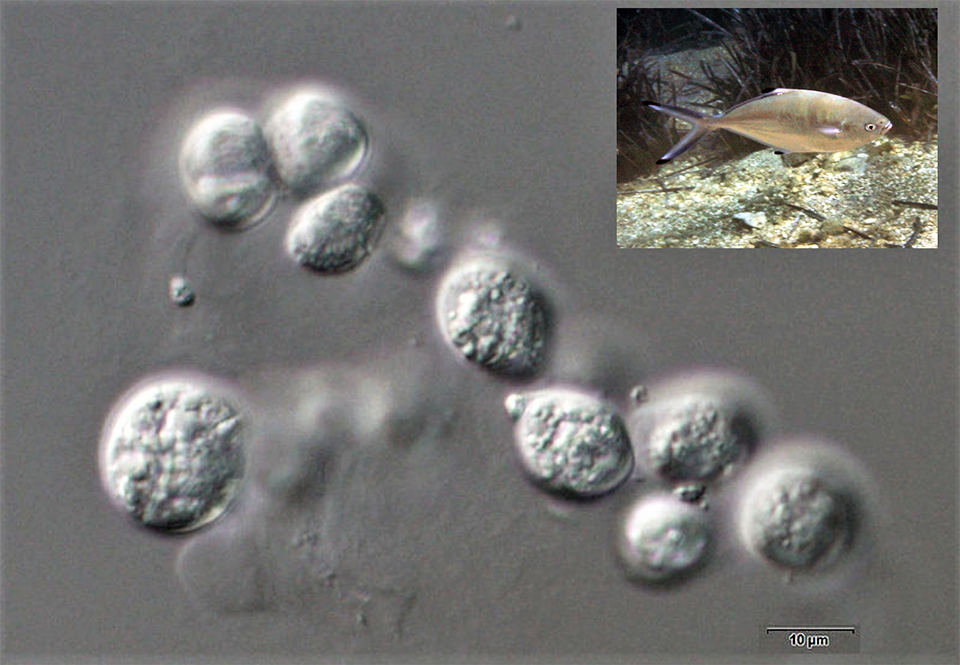
Improving the functionality of aquafeeds through the proper addition of nutrients can help promote the immunity and growth of farmed seafood species. Unsaturated fatty acids (FAs), which are essential nutrients for marine fish, show a wide range of important biological functions. Omega-3 polyunsaturated fatty acids (PUFAs) are an important category of unsaturated fatty acids. Several omega-3 PUFAs – including eicosapentaenoic acid (EPA), linolenic acid (ALA) and docosahexaenoic acid (DHA) – play an essential role in promoting the growth or boosting the immunity of fish, while EPA and DHA are known to help fish reduce inflammatory factors and reduce inflammation. Moreover, as essential nutrients for the development of marine fish, EPA and DHA can promote the growth of fish.
In recent years, various marine microalgae have been reported as a vital source of unsaturated FAs and have been increasingly used as a fish feed additive. The marine microalgae Aurantiochytrium sp. has attracted increasing attention due to its rich production of omega-3s. It can be mass-produced at low cost through industrial fermentation and is a stable source of omega-3s. Its fatty acid content can reach 389 mg per gram (with 68 to 74 percent PUFA and 42 to 44 percent essential PUFAs (EPA, ARA and DHA).
Aurantiochytrium sp. has been used as a fish feed additive and its dietary addition can increase the content of omega-3s, especially DHA, in marine fish. Published studies report that increasing its content in fish feed reduces fat level in fish livers, and that fatty acid accumulation and meat quality of fish increased. Other studies have shown that adding Aurantiochytrium sp. to fish feed can reduce energy and FA apparent digestibility and improve the growth performance of marine fish.
The silver pompano (Trachinotus ovatus) is a carnivorous marine fish whose meat is highly regarded by consumers and it is a valuable, cultured fish in the southeast coastal areas of China and other areas in the region. This article – adapted and summarized from the original publication (Li, S. et al. 2021. Enhanced Growth Performance Physiological and Biochemical Indexes of Trachinotus ovatus Fed with Marine Microalgae Aurantiochytriumsp. Rich in n-3 Polyunsaturated Fatty Acids. Front. Mar. Sci., 24 January 2021.) – reports on research to evaluate the effects of dietary Aurantiochytrium sp. on the growth performance and immune response of T. ovatus.
Study setup
The T. ovatus used in this experiment had an initial weight of 8.00 ± 1.00 grams and were procured from Shenzhen Taifeng Oriental Marine Biotechnology Co., Ltd. The fish were reared for 14 days before the start of the experiment. Fish were weighed, and animals of similar size were randomly allocated to 14 sea cages (0.7 × 0.5 × 1.0 meters; two cages per diet treatment); each cage was stocked with 50 fish and had an aeration system. The total weight of the 50 fish in each cage/treatment was similar to ensure that there were no significant differences.
Aurantiochytrium sp. was isolated from mangroves in the coastal waters of southern China and were screened and processed into a powder. Various percentages of this Aurantiochytrium sp. powder were added to the fish feeds: diet 1: 0 percent; diet 2: 1 percent; diet 3: 3 percent; diet 4: 5 percent; diet 5: 7 percent; diet 6: 9 percent; and diet 7: 11 percent. All the feed ingredients were crushed through an 80-mesh steel sieve, mixed and formed into pellets, dried at 30 degrees-C for 72 hours and stored in a refrigerator at minus-20 degrees-C for later use.
During the eight-week trial, fish were fed twice daily, with feed rations adjusted based on a percentage of fish body weight. The body length and body weight were recorded for each fish every week; mortalities were also recorded, as well as various other observations on fish health, behavior and on water quality.
For detailed information on the experimental design and fish husbandry; fish feed preparation and nutritional composition; collections of samples; physiological and biochemical analyses; and statistical data analyses, refer to the original publication.
Results and discussion
Omega-3 PUFAs are essential fatty acids that play important roles in fish growth and metabolism. However, the minimum requirements for PUFAs differ for different types of fish. Fish lacking PUFAs exhibit growth retardation and lack of vitality and will suffer from seriously reduced feed conversion efficiency. Growth performance parameters are the most direct reflection of fish growth and nutritional status. The survival rate and feed efficiency (FE, percent; wet weight gain/dry diet fed) can also reflect health status and energy-use efficiency.
We studied growth performance and immune response of T. ovatus by using fish diets with various microalgae content from 1 to 11 percent for eight weeks. The results showed that, with the addition of Aurantiochytrium sp., the survival rate, weight gain rate, and specific growth rate of fish increased by a maximum of 1.02, 1.16 and 1.08 times, respectively, indicating that the intake of marine microalgae Aurantiochytrium sp. was beneficial for fish growth. As the microalgae content increased, the feed utilization efficiency index feed conversion ratio decreased (maximum 15 percent) and feed efficiency increased (maximum 1.17 times), showing that the addition of Aurantiochytrium sp. contributed to the assimilation of fish feed.
Our results show that dietary Aurantiochytrium sp. supplementation significantly improved the weight gain rate (WGR) and specific growth rate (SGR, final individual weight – initial individual weight/number of days) of T. ovatus compared with the supplemented group. The feed efficiency and other results related to energy conversion efficiency also showed that the ability of T. ovatus to absorb energy from their diet improved after supplementation with dietary Aurantiochytrium sp. As seen from the study data, Aurantiochytrium sp. provides sufficient DHA and other fatty acids necessary for the growth of T. ovatus. In addition, the algal-derived DHA can also increase the feed efficiency rate and stimulate the growth performance of aquatic animals. These results indicate that Aurantiochytrium sp. addition promotes the growth of T. ovatus by improving its energy-conversion efficiency.
Fish plasma [the liquid portion of blood] is closely involved in fish metabolism, nutrition and health status. Blood biochemical indicators are widely used to evaluate fish health, nutrition and environmental adaptation. Plasma protein concentration can be affected by dietary protein intake and can be used as an indicator of individual nutritional status to a certain extent. The higher the total protein content in fish serum, the higher the fish’s absorption and metabolism levels, and the higher the efficiency of protein synthesis and nitrogen deposition.
In our study, as dietary Aurantiochytrium sp. increased from 0 to 11 percent, the protein content in the blood also significantly increased and was maintained at a high level. When dietary Aurantiochytrium sp. was at 11 percent the weight of the feed, the total amount of protein in the blood was four times that in the control. Previous research has shown that adding Aurantiochytrium sp. to feed can increase the protein content in other fish species. Our results show that adding Aurantiochytrium sp. to feed can improve protein efficiency and increase the nutritional status of T. ovatus.

Blood glucose and triglyceride levels reflect energy and fat metabolism in fish. Generally, when the blood glucose level is high, the fish feed has a higher energy level and greater vitality, but excess glucose is more likely to be converted into fat for storage in the body. Triglyceride content is an important indicator of blood fat levels. Our results showed that, as the omega-3 PUFA content in the feed increased, the glucose content in the blood increased from 9 to 27 percent. In addition, for fish fed feed with Aurantiochytrium sp., compared with the control, the blood triglyceride content in each experimental group significantly decreased. These results indicate that omega-3 PUFAs can reduce the energy expenditure index and improve the energy absorption efficiency of T. ovatus.
Our data also indicated that oils from microalgae, when engineered to contain high levels of EPA and DHA, can replace fish oil in feeds for other cultured marine fish species and allow complete replacement of fish oil in combination with more cost-effective lipid sources, such as poultry and rapeseed oils. Furthermore, more EPA-DHA synthesis will lead to a decrease in ALA content. We speculated that, with the increase in DHA content, the conversion process of ALA to DHA may be inhibited by feedback. In addition, the direct absorption and deposition of DHA may be inhibited by increased DHA conversion. However, the increase in FA content can protect the fish liver and increase the economic value of T. ovatus.
The blood composition of fish is affected by a variety of endogenous factors, including nutrition status and individual size, and exogenous factors, including light, temperature and dissolved oxygen. Some blood indicators (red blood cells, RBC; and white blood cells, WBC) are used to assess the physiological and pathological conditions of fish. Our results showed that, compared with the control, the RBCs in the feed groups was significantly increased, which indicates that Aurantiochytrium sp. can indeed enhance the RBC immunity of T. ovatus.
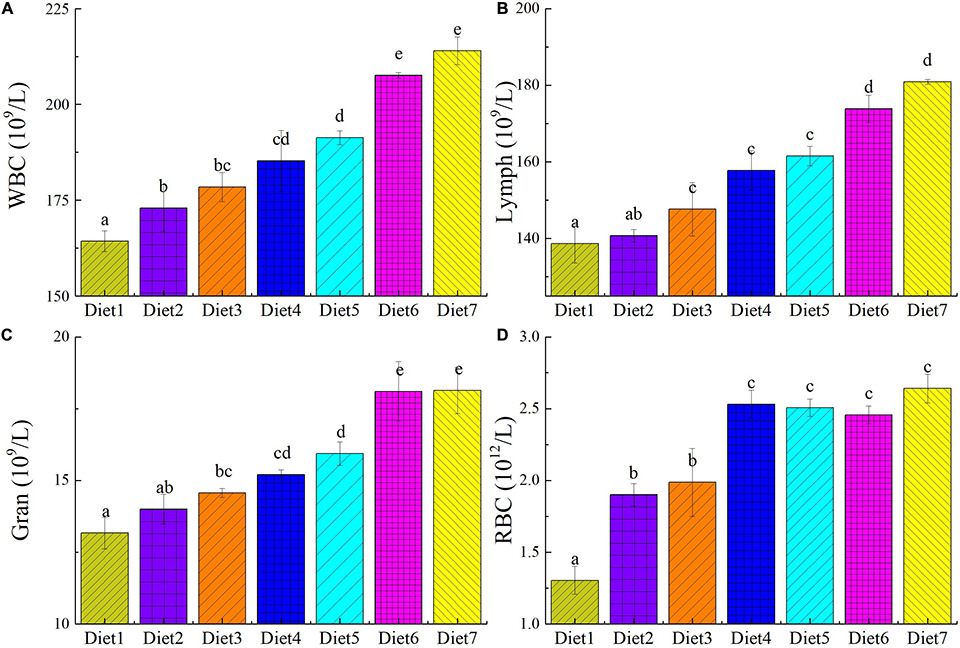
Also, the number of WBCs, granulocytes [involved in host defense and immune regulation] and lymphocytes [involved in the specific immune response of the body] in the blood of the experimental fish group significantly increased compared with the control group, and the overall trend in growth remained stable. Generally, the number of WBCs in fish will increase due to environmental stress, but there was no significant difference in the proportion of lymphocytes and granulocytes in the total number of WBCs in each experimental group. This shows that the increase in leukocyte number was not caused by external environmental stress, but rather by improvements in immunity. Overall, our data show that the supplementation of dietary omega-3 PUFAs can increase immunity in T. ovatus.
Perspectives
In our study of growth performance and immune response of T. ovatus using diets with various microalgae content from 1.00 to 11.00 percent, we demonstrated that the addition of the marine microalgae Aurantiochytrium sp. Increased fish survival rate, weight gain rate, and specific growth rate by a maximum of 1.02, 1.16 and 1.08 times, respectively, indicating that the intake of the marine microalgae was beneficial for fish growth.
As the microalgae content increased, the feed utilization efficiency index feed conversion ratio decreased (maximum 15.00 percent) and feed efficiency increased (maximum 1.17 times), showing that the addition of Aurantiochytrium sp. contributed to the assimilation of fish feed. The addition of Aurantiochytrium sp. also improved various physiological and biochemical indexes in the experimental fish, indicating that microalgae rich in omega-3 PUFAs could increase the number of immune cells, thus helping to improve fish immunity and disease resistance.
Now that you've reached the end of the article ...
… please consider supporting GSA’s mission to advance responsible seafood practices through education, advocacy and third-party assurances. The Advocate aims to document the evolution of responsible seafood practices and share the expansive knowledge of our vast network of contributors.
By becoming a Global Seafood Alliance member, you’re ensuring that all of the pre-competitive work we do through member benefits, resources and events can continue. Individual membership costs just $50 a year.
Not a GSA member? Join us.
Author
-
Xuewei Yang, Ph.D.
Corresponding author
Guangdong Key Laboratory of Plant Epigenetics
Guangdong Technology Research Center for Marine Algal Bioengineering
College of Life Sciences and Oceanography
Shenzhen University
Shenzhen, China
Editor’s note: This article has 11 co-authors but only the corresponding author, Dr. Xuewei Yang, is listed.[110,99,46,117,100,101,46,117,122,115,64,119,120,103,110,97,121]
Related Posts
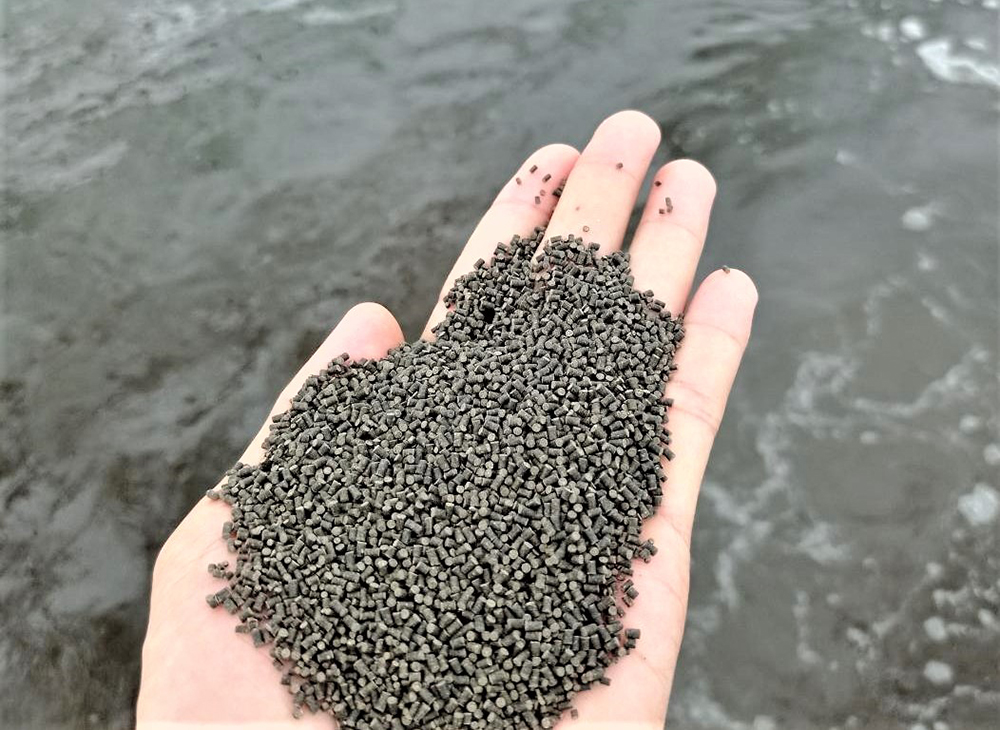
Aquafeeds
Macronutrient research in aquaculture nutrition
Proteins, lipids and carbohydrates require equal consideration for aquafeed formulators, as each macronutrient influences performance and feed conversion.
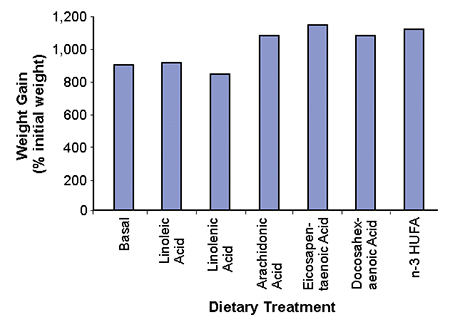
Health & Welfare
Advances in triglyceride, fatty acid nutrition in penaeid shrimp
Dietary lipids are necessary for the growth, survival and metabolic functions. Triglycerides are the main form in which humans ingest and accumulate fat.
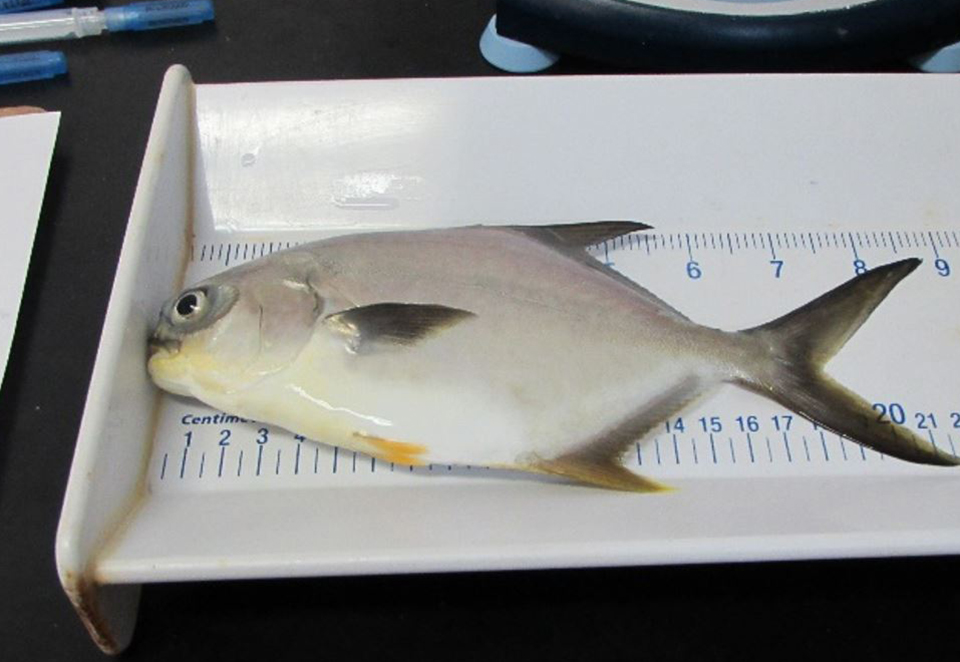
Aquafeeds
Evaluating dietary fish oil replacement in juvenile Florida pompano
Study evaluated production performance and tissue composition of juvenile Florida pompano fed diets containing fish oil or 25:75 blends of fish oil and various other lipid sources.
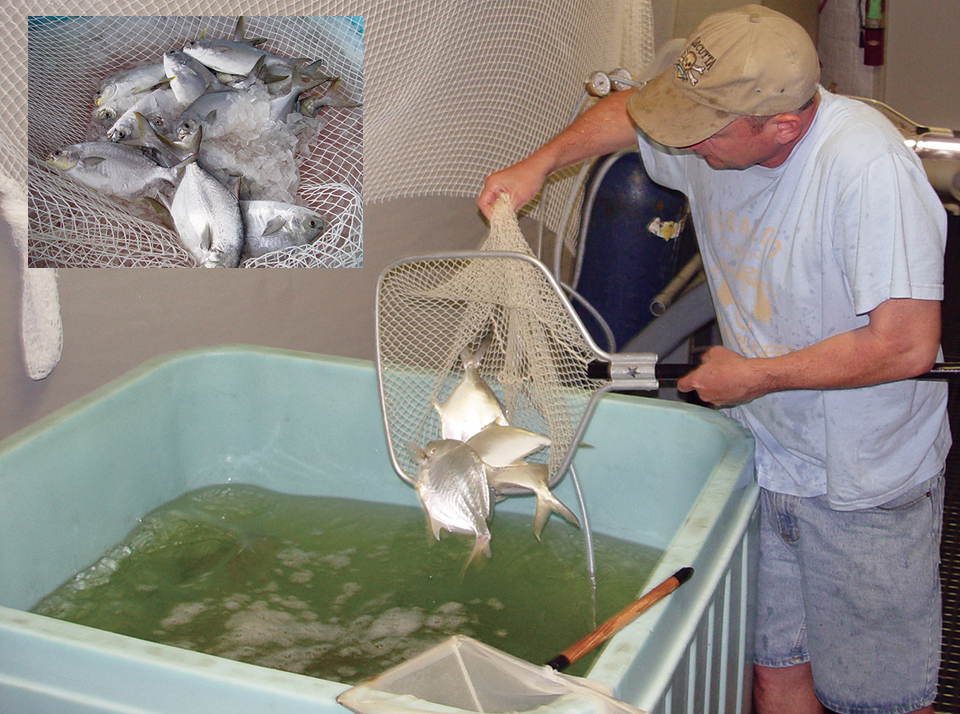
Health & Welfare
Pompano reared to market size in RAS
In a trial, rearing density affected the mean weight and weight gain of pompano, although differences between treatments became apparent toward the end of the study.


